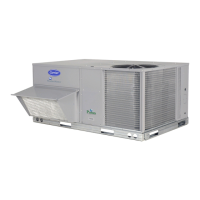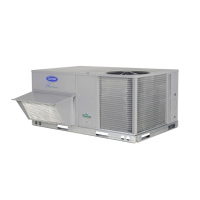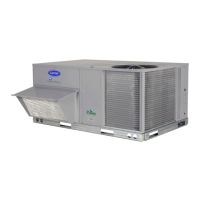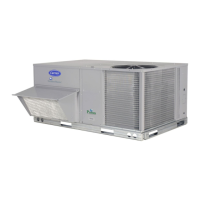Indoor Airflow — The indoor airflow does not require
checking unless improper performance is suspected. If a prob-
lem exists, be sure that all supply- and return-air grilles are
open and free from obstructions, and that the air filter is clean.
When necessary, refer to Indoor Airflow and Airflow Ad-
justments section on page 22 to check the system airflow.
Metering Devices — Refrigerant metering devices are
fixed orifices and are located in the inlet header to the indoor
and outdoor coils.
Liquid Line Strainers — The liquid line strainers (to
protect metering device) are made of wire mesh and are lo-
cated in the liquid lines on the inlet side of the metering
devices.
Check valves are also located in the liquid lines near
the strainers. The strainers are the larger of the two
components.
Table 11 — Cooling and Heating Troubleshooting Chart
SYMPTOM CAUSE REMEDY
Compressor and out-
door fan will not start.
Power failure Call power company.
Fuse blown or circuit breaker tripped Replace fuse or reset circuit breaker.
Defective thermostat, contactor, transformer,
control relay, or defrost board
Replace component.
Insufficient line voltage Determine cause and correct.
Incorrect or faulty wiring Check wiring diagram and rewire correctly.
Thermostat setting too high Lower thermostat setting below room temperature.
Units have a 5-minute time delay DO NOT bypass this compressor time delay — wait
for 5 minutes until time-delay relay is deenergized.
Compressor will not
start but outdoor fan
runs.
Faulty wiring or loose connections in
compressor circuit
Check wiring and repair or replace.
Compressor motor burned out, seized, or
internal overload open
Determine cause. Replace compressor.
Defective run capacitor, overload,
or PTC (positive temperature coefficient)
thermistor
Determine cause and replace.
One leg of 3-phase power dead Replace fuse or reset circuit breaker.
Determine cause.
Low input voltage (20% low) Determine cause and correct.
Three-phase scroll
compressor
(size 048 and 060
units only) makes ex-
cessive noise, and
there may be a low
pressure differential
Scroll compressor is rotating in the
wrong direction
Correct the direction of rotation by reversing the
3-phase power leads to the unit.
Compressor cycles
(other than normally
satisfying thermostat).
Refrigerant overcharge or undercharge Recover refrigerant, evacuate system, and recharge
to capacities shown on nameplate.
Defective compressor Replace and determine cause.
Insufficient line voltage Determine cause and correct.
Blocked outdoor coil Determine cause and correct.
Defective run/start capacitor, overload,
or start relay
Determine cause and replace.
Defective thermostat Replace thermostat.
Faulty outdoor-fan motor or capacitor Replace.
Damaged reversing valve Determine cause and correct.
Restriction in refrigerant system Locate restriction and remove.
Compressor operates
continuously.
Dirty air filter Replace filter.
Unit undersized for load Decrease load or increase unit size.
Thermostat set too low Reset thermostat.
Low refrigerant charge Locate leak, repair and recharge.
Leaking valves in compressor Replace compressor.
Frosted coil with incorrect defrost operation Check defrost time settings. Reset as necessary.
Check defrost temperature switch. Replace as necessary.
Air in system Recover refrigerant, evacuate system, and recharge.
Outdoor coil dirty or restricted Clean coil or remove restriction.
30

